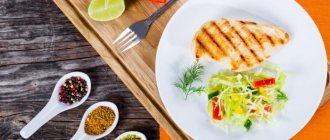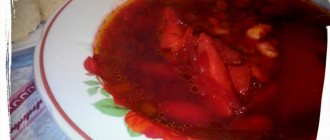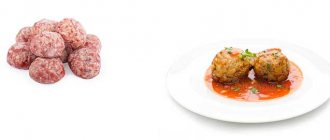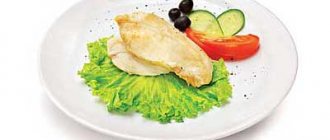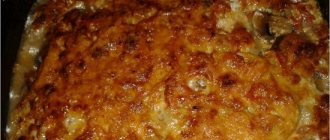It's hard to find a person who doesn't love kebab. We strongly associate this dish with a picnic in nature, the cheerful crackling of a fire, fragrant smoke and noisy company. Shish kebab is so popular that we sometimes forget that this dish is the national pride of the Caucasian peoples and residents of Central Asia.
Each nation has its own special way of preparing shish kebab. In Transcaucasia, it is traditionally prepared from lamb, however, the calorie content of kebab from this meat is quite high.
Today, many restaurants, cafes and bars offer their visitors different types of kebab. The menu surprises with its variety, and the chefs' imagination knows no bounds: we are offered meat kebabs, fish and seafood kebabs, mushroom and vegetable kebabs. How many calories are in kebabs made from various products?
Calories in pork kebabs and calories in kebabs from other types of meat
The calorie content of meat kebab depends on the following factors:
- What type of meat is the kebab made from (lamb, pork, veal, poultry, rabbit, etc.);
- What part of the animal carcass was it taken from (neck, tenderloin, etc.);
- What marinade is used;
- Cooking method.
Calorie content of lamb kebab.
Lamb is a very fatty meat, but it is ideal for barbecue. Having a specific taste, after soaking in the marinade, lamb acquires the most delicate texture and excellent taste. How many calories are in lamb kebab? This depends not only on the calorie content of the meat, but also on the type of marinade.
Calorie content of lamb kebab for various cooking methods:
- Lamb shish kebab (loin) in natural pomegranate juice – 225 kcal/100 g;
- Lamb kebab (loin) in pomegranate sauce – 238 kcal/100 g;
- Lamb shish kebab in kumis marinade – 229 kcal/100 g;
- Lamb kebab (loin or neck) in ayran marinade (fermented milk product with mineral water) – 218-222 kcal/100 g;
- Calorie content of lamb kebab in wine sauce – 235 kcal/100 g.
Calories in pork kebab
The calorie content of pork kebab is also high, but the calorie content can be reduced by choosing a less fatty part of the carcass (breast, shoulder). For comparison, the energy value of a pork shoulder is about 257 kcal/100 g, the brisket is 180 kcal/100 g, the neck is 273 kcal, and the lower part of the breastbone (dewlap) is 587 kcal/100 g.
Calories in pork kebab (from lean parts of the carcass) in various marinades:
- Pork shish kebab in kefir marinade – 192-215 kcal/100 g;
- Pork shish kebab in natural tomato juice – 188-206 kcal/100 g;
- Calorie content of pork kebab marinated in vinegar and lemon is 175-195 kcal/100 g;
- Pork kebab in beer – 267 kcal/100 g;
- Pork kebab in mayonnaise – 258.87 kcal/100 g;
Calorie content of beef kebab.
Beef shashlik contains fewer calories than lamb and pork. For this dish, it is best to use beef tenderloin or rump - then the meat will be tender and juicy. The taste of such kebab will certainly be remembered for a long time.
Calories in lean beef kebabs with a variety of marinating methods:
- Beef kebab in dry red wine with onions – 169-180 kcal/100 g;
- Beef shish kebab in mustard dressing - 148 kcal/100 g;
- Calorie content of kebab marinated with whey and spices – 145 kcal/100 g;
- Beef shish kebab in sour cream and tomato sauce – 174 kcal/100 g;
- Beef shish kebab in wine vinegar with apple juice – 145-180 kcal/100 g.
Composition and calorie content of kebab
As we know, shish kebab is a traditional dish of the peoples of the Caucasus, but in our country it has taken root so much that we already consider it “ours.”
This is meat marinated in various sauces and spices, fried on a spit or on a grill over hot coals. In addition to meat, fish, seafood, mushrooms, vegetables and even fruits are used for barbecue. It’s hard to imagine summer without trips with friends to the dacha or the forest and without the traditional barbecue, on which meat lies skewered or laid on a grill.
In the composition of kebab, the main place is occupied by proteins and fats. Depending on the fat content of the meat, kebab contains on average about 12 g of protein and 10 g of fat per 100 g. Meat contains practically no carbohydrates - there are none at all in raw meat, and very little in marinated meat. So the main sources of calories in kebab are proteins and fats . Moreover, if the amount of proteins in meat, as a rule, does not change much depending on the piece of carcass, then the fat content changes very much - and along with the fat content of the meat, the calorie content of the kebab also changes.
This dish contains vitamins A, C, E, H, PP, B vitamins, including choline, as well as calcium, magnesium, sodium, potassium, phosphorus, chlorine, sulfur, iron, zinc, iodine, copper, manganese, chromium, fluorine, molybdenum, boron, cobalt, aluminum, nickel, rubidium, etc. - a very rich vitamin and mineral composition. The average calorie content of kebab is from 130 to 180 kcal per 100 g, but, as mentioned above, it very much depends on the fat content of the meat.
Calorie content of chicken kebab
The most delicious kebab comes from the top part of the chicken leg - the thigh with the bone. Prepared according to all the rules, such a kebab will delight you with its excellent taste and delicate flesh. Chicken kebab has a slightly lower calorie content than kebabs made from cattle meat, because poultry has always been considered dietary meat.
Calorie content of chicken kebab (without the top skin - we don’t use it) when marinated in different sauces:
- Chicken kebab in kefir – 140 kcal/100 g;
- Calorie content of chicken kebab with soy sauce – 155 kcal/100 g;
- Chicken kebab in honey marinade – 198 kcal/100 g;
- Chicken shashlik in mayonnaise with spices – 183 kcal/100 g;
- Calorie content of shish kebab made from chicken hearts is 152 kcal/100 g.
In addition to chicken, you can use turkey for making barbecue, especially since this meat has excellent taste.
Calorie content of turkey shish kebab (fillet):
- Turkey kebab in sweet and sour sauce – 115-128 kcal/100 g;
- Turkey kebab in mineral water with seasonings – 113-119 kcal/100 g;
- Turkey kebab calories in white wine marinade – 134 kcal/100 g;
- Turkey kebab in vinegar-lemon dressing – 115-122 kcal/100 g.
What to remember about eating kebabs
Shish kebab is indeed a very satisfying and healthy dish, but it is not without harmful properties. When fat burns, carcinogens are formed. The more appetizing the kebab crust is, the more crunchy it is, the more harmful it is. Carcinogens with frequent use increase many times
risk of cancer in humans. But every cloud has a silver lining - the sour marinade in which meat for barbecue is cooked helps to partially neutralize the effect of carcinogens.
It also protects us from poisoning - after all, if you undercook the meat a little, you can get poisoned by it. However, even the marinade is sometimes powerless against kebab, which unscrupulous producers prepare from expired or spoiled meat. It’s easy to recognize such a kebab - a lot of vinegar or mayonnaise, a lot of pepper, a lot of salt - everything to hide the taste and smell of spoiled meat.
The calorie content of kebab made from fatty meats can harm your figure . This should also not be forgotten. Choose lower calorie types of kebabs. Avoid eating kebab if you have chronic or acute diseases of the stomach or intestines. Fatty kebab is contraindicated for people with liver and pancreas disease.
How many calories are in fish kebab?
Fish kebab is not only a tasty dish, but also healthy. Fish is an easily digestible protein, and if you fry it without any fat, there will be no risk to your figure. Fatty fish varieties are best suited for barbecue (they are tastier and more nutritious), but you can also use low-fat sea fish (in this case the calorie content of the barbecue will be lower).
Calorie content of kebab from different types of fish:
- Salmon kebab in soy sauce – 88.7 kcal/100 g;
- The calorie content of eel kebab is very high - 346 kcal/100 g (eel is a high-calorie fish);
- Tuna kebab – 139 kcal/100 g;
- Salmon shish kebab – 168-220 kcal/100 g;
- Sturgeon kebab – 110 kcal/100 g;
- Mackerel kebab – 153-177 kcal/100 g;
- Calorie content of trout kebab is 113-128 kcal/100 g.
As a rule, fish kebab does not require the preparation of complex multi-component marinades - it will be enough to just lightly salt and pepper portions of fish. It is unacceptable to marinate fish in fermented milk products or mayonnaise sauce, as the fish will lose its unique delicate taste and characteristic aroma. Soy sauce and dry curry-based seasonings can be used as a dressing for fish kebab.
Calorie content of fish and seafood kebab
The protein contained in fish is absorbed better than all other animal proteins. Fish is rich in vitamins A, D, E, B vitamins, vitamins PP and K, as well as phosphorus, calcium, iodine, fluorine, zinc and other minerals necessary for the body. Fish contains essential polyunsaturated fatty acids omega-3 and omega-6, which prevent aging of the body, regulate metabolism and have a general strengthening effect. Naturally, kebab made from this product has all the beneficial properties inherent in fish, in addition, it is juicy, tender and very tasty.
The calorie content of salmon kebab with dill in mustard marinade is 130 kcal per 100 g . The calorie content of salmon kebab marinated in soy sauce is 89 kcal per 100 g. The calorie content of tuna kebab is 139 kcal per 100 g, of sturgeon - 110 kcal per 100 g, of salmon - 180 kcal per 100 g, of trout - 120 kcal per 100 g. The calorie content of kebab made from tiger shrimp is 147 kcal per 100 g, from squid - 120 kcal per 100 g, from regular shrimp in oil - 110 kcal per 100 g; The calorie content of mussel kebab is about 85 kcal per 100 g.
Serving kebab
When reducing the calorie content of pork kebab, you should also remember what additional products to serve it with. It is very useful to serve greens or various herbs with meat, but sauces, ketchups and other seasonings and spices will have to be excluded. Also, do not eat this dish with potatoes.
It is best to use fresh vegetables as a side dish; it is necessary to significantly reduce the consumption of bread. If all recommendations are followed, you can eat your favorite dish without thinking about calories.
How to neutralize calories in pork kebab?
Even if kebab is made from lean pork, it cannot be called low-calorie. But it’s possible to reduce the number of calories and damage to your waistline.
It is better to eat shish kebab with vegetables, which contain a lot of fiber, which reduces the time food spends in the digestive organs. The ratio should be like this:
- for 1 serving of lean pork kebab - 2 servings of vegetables;
- for 1 serving of fatty pork kebab - 3 servings of vegetables.
The source of extra calories is sauces. For example, tkemali has 181 kcal, ketchup - 118 kcal, tartar sauce - 211 kcal.
But adjika has only 59 kcal. There are many recipes for this Caucasian sauce. In one version, the composition includes red tomatoes, bitter and sweet capsicums, wine vinegar, garlic, and cilantro. “Green adjika” is also prepared - from spicy herbs (cilantro, basil, dill), hot capsicum, coriander seeds, garlic.
Adjika also has beneficial properties - it improves metabolism, normalizes digestion, and the functioning of the circulatory system. This means that the pork will be digested faster by the body.
Do you want pork kebab? Cheers! The harm from its use can be minimized if you choose the right:
- pork;
- marinade;
- snack;
- sauce.
Do you want to lose weight? Then these articles are for you
Zumba fitness: video lessons for weight loss in Russian
How to quickly lose belly and side fat in a week
How to quickly gain weight for a man?
The benefits of shish kebab
We should not think that taste is the only thing that kebab can offer us. Pork, which has the highest calorie content of all types of meat (257 kcal per 100 grams), is both very healthy and easily digestible.
Pork fat poses less danger to the heart and blood vessels than beef fat. And this type of meat cannot be called the fattest. Per 100 grams of this product there are 2.98 grams of fat, while the same amount of chicken contains 3.03 grams.
This meat also contains a large amount of protein and B vitamins. The product is often recommended for nursing mothers, as it promotes the formation of breast milk.
Particularly pleasing is the fact that during the process of preparing barbecue, the beneficial properties are lost more slowly than with other methods of heat treatment of meat. Coals have a weak effect on the product, but this is enough to eliminate most of the harmful bacteria. And the calorie content ends up being less than if the pork were cooked in the usual way.
Properly prepared kebab helps prevent arthritis.
